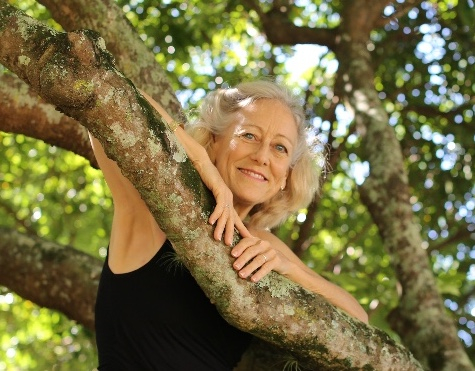
I usually count on my plane rides between the continental US and Hawai’i as a time to power through 5 hours of work. Taking my seat next to Ki-Lin Reece, I found myself dropping that plan.
Thank goodness!
As I listened to my seat partner’s background and current work, I simply couldn’t bear to open my laptop. I kept wanting to hear more. Internally, I shook my head in wonder: Here’s this guy, originally from Berkeley, California, who got his kicks as a kid taking guitars apart. How is it that he is now devotedly putting together not just broken ukuleles, but also the scattered fragments of Hawaiian musical history? Who is this man who loves Hawaiian music so much?
Ki-Lin Reece is a luthier. Luthiers create and repair stringed instruments – such as lutes! When Ki-Lin (pronounced Kai-Lin) arrived on the islands ready to repair broken instruments and build new ones, he did not guess that he would be fitting together pieces of Hawai’i’s musical past to tell the story of her musical present.
Exhilarated hearing Ki-Lin’s work, I got home and asked my friend and colleague, Sarah Hodges, herself a skilled violinist at many a local kanikapila (music jam), to interview my new acquaintance for more details. This tale, therefore,  represents a collaborative effort between Sarah, me, and of course Ki-Lin.
represents a collaborative effort between Sarah, me, and of course Ki-Lin.
At age 12 Ki-Lin was disassembling musical instruments to understand how they worked. At 16 he began apprenticing with a luthier in Berkeley, and by the time he graduated from high school he had the skills to repair and build string instruments as well as to play them. He went on to study jazz and bluegrass history in both California and New York.
Reece arrived on the island in 2002 and opened his instrument shop, KR Strings, in Kailua, here on the island of O‘ahu. His loving, skilled touch with the instruments quickly won him the trust of Hawai’i’s many and varied musicians. He fixed everybody’s instruments, from the most famous musicians of Hawai’i to the plumbers, mechanics, farmers, and school teachers.
“Every time customers brought in a broken instrument, they would tell me stories that I just couldn’t forget. They would say, ‘Oh, yeah, my great grandmother was on tour in  the 1920’s with so-and-so’, or tell me how a family member went to China, Japan, India, or Sri Lanka performing on a certain instrument,” recounts Ki-Lin. For years, he listened in amazement and awe as countless stories rolled through his music shop.
the 1920’s with so-and-so’, or tell me how a family member went to China, Japan, India, or Sri Lanka performing on a certain instrument,” recounts Ki-Lin. For years, he listened in amazement and awe as countless stories rolled through his music shop.
In addition to the remarkable people Ki-Lin was blessed to meet were the historic entities of wire and wood. One day while traveling through Kealekekua on the Kona coast of the Big Island an antique store owner mentioned that he knew where the personal guitar of Prince Jonah Kūhiō Kalanianaʻole was. After a year of following the lead, Ki-Lin’s nonprofit organization the Kealakai Center for Pacific Strings was able to purchase the guitar, which dates to roughly 1912.
Ki-Lin surmises that the guitar’s nautical star inlay may have signified the many ocean voyages the Prince made between Honolulu and Washington, DC, where he worked as Hawaii’s first representative to the US Congress. The unusual scroll motif inlaid at the base of the guitar looks very much like Prince Kuhio’s famous handle-bar mustache. What a historic treasure!
Ki-Lin intends to restore the guitar to playable condition and share it with Hawai’i’s youth through a song contest for strings, where the winner would have a chance to record his or her Mele with the guitar at a historic location like Washington Place, or ‘Iolani Palace.
Ki-Lin came to learn that members of Hawaii’s monarchy were all skilled musicians and even composers. That fact told him how deeply embedded music was in the heart of the Hawaiian people.
He found himself rescuing some of the old instruments coming into his shop just in time to restore them before it was too late. Ki-Lin began to realize that many of the stories about the instruments and their owners were similarly in danger of being completely lost. Ki-Lin got to thinking. Each of the instruments that came through his hands was not only a tool for sharing stories through song, but somehow the instruments were also vehicles of their own stories, somehow holding a whole, intricate, interwoven story  of a people within their very wood and strings.
of a people within their very wood and strings.
Ki-Lin came to understand that the greater unifying story – of these instruments, their builders, their owners, and their owners’ music – hadn’t been brought together. Without the greater story, some families didn’t have the context within which they could appreciate the legacy and contributions their aunties, uncles, and other family members had made to the modern global soundscape.
Bits and pieces of the bigger story began making their way to Ki-Lin in the form of old black-and-white photographs of Hawaiian brass and string bands, vinyl records from the past, signatures and stories of the luthiers who had built the ukuleles, guitars, and violins of previous decades or centuries, and old Hawaiian sheet music that he found in dusty antique shop piles.
As Ki-Lin learned more names of musicians and instrument makers on the islands, he was able to fit together connections and began to grasp the magnitude of the musical heritage that Hawaiians had produced… and are STILL producing.
It dawned on Ki-Lin: “Hawaiʻi is a musical epicenter. To really celebrate Hawaiʻi’s origin story of music, we don’t need to talk about what was brought here from the outside. We don’t need to talk about what happened in New Orleans or Harlem or New York. We can describe everything that has led to the Hawaiian music heard around the world from right here. We can see the intersection of brass band culture and a global array of stringed instruments.” 
He goes on to explain: “Music education was central to Hawaiian culture, and the 19th century Hawaiian Kingdom led the world in music education, and literacy. This birthed a profound renaissance in the musical arts, the effects of which are everywhere one looks and listens. All the ingredients are right here to tell these stories.” He goes on to tell, for example, about all the Hawaiian language newspaper articles stored at Bishop Museum, but not yet digitized.
Deeply inspired by the stories these instruments carry and the families to whom they have been entrusted, Ki-Lin founded the non-profit organization, Kealakai Center for Pacific Strings. Read more here. The organization seeks to preserve the instruments, the music, and the history that they hold.
As it turns out, their task is ginormous! Over the past ten years, Ki-Lin and a dedicated team have worked tirelessly to preserve, educate, and share a fuller story of the music of Hawai’i and the Pacific, for the greater understanding of its history and place in the world. And the work is also up close and personal. He told me how he’s teaching kids to repair their
repair their ʻohana’s (family’s) damaged ʻukuleles and guitars to return them to their grandparents in playable condition again.
ʻohana’s (family’s) damaged ʻukuleles and guitars to return them to their grandparents in playable condition again.
Seldom has a seat-mate so fully captivated my attention. I’m glad I met Ki-Lin on the plane to learn of his remarkable endeavors to keep the voices of these instruments alive and their rhythms thrumming into the future…for the love of music!

Renée Tillotson
Renée Tillotson, Director, founded Still & Moving Center to share mindful movement arts from around the globe. Her inspiration comes from the Joy and moving meditation she experiences in the practice of Nia, and from the lifelong learning she’s gained at the Institute of World Culture in Santa Barbara, California. Engaged in a life-long spiritual quest, Renée assembles the Still & Moving Center Almanac each year, filled with inspirational quotes by everyone from the Dalai Lama to Dolly Parton. Still & Moving Center aspires to serve the community, support the Earth and its creatures, and always be filled with laughter and friendship!

Get the Still & Moving App
This post is also available in: 日本語 (Japanese)

